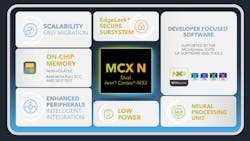NPU-Equipped Dual-Core MCU Tackles AI Chores
The latest multicore system-on-chip (SoC) from NXP Semiconductors is based on dual 150-MHz Arm Cortex-M33 cores (Fig. 1). The MCX N series adds features such as a neural processing unit (NPU). The Cortex-M33 cores can deal with lightweight machine-learning (ML) chores, but the NPU provides a significant performance boost while utilizing less power. As a result, ML models can be handled on-chip instead of pushing data to the cloud.
Security and safety are high on its list of features, which include the EdgeLock security subsystem and 2 MB of flash memory that can optionally include ECC-supported RAM. It’s part of the MCX family that includes ultra-low power and wireless options.
The EdgeLock subsystem has a hardware random number generator (RNG) and provides acceleration for AES-256 and ECC-256. It has tamper- and glitch-detection plus its own one-time-programmable memory array, as well as physically unclonable function (PUF) SRAM. The PRINCE acceleration provides on-the-fly encryption and decryption of flash data. This works with off-chip memory such as eXecute-in-Place (XIP) serial memory.
The two Cortex-M33 cores are not equal. One is a basic core; the primary core incorporates TrustZone, FPU, SIMD, and DSP support along with control of the memory protection unit (MPU).
The top-end MCX N94X family adds a CoolFlux DSP to the mix along with enhanced motor-control support that has dual encoders, a SINC filter, and dual FlexPWMs (Fig. 2). In addition, there’s a four-channel, 16-bit ADC; dual 12-bit, 1-Msample/s DACs; and a 14-bit, 5-Msample/s DAC, as well as three on-chip op amps.
The chips offer up to 10 Flexcomm interfaces that handle standard peripheral interfaces like UARTs, SPI, and I2C. There’s also support for full-speed USB with a high-speed USB hub, dual CAN-FD interfaces, Ethernet, and dual I3C interfaces.
SoCs like the MCX N are becoming quite complex with multiple, unique cores to manage everything from motor control to communication to security. This leads to significant advantages in terms of cost and integration, but it can be more challenging when it comes to software development.
NXP’s eIQ machine-learning software-development environment supports the MCX series as well as other NXP chips. It can work with models from most popular AI frameworks.



